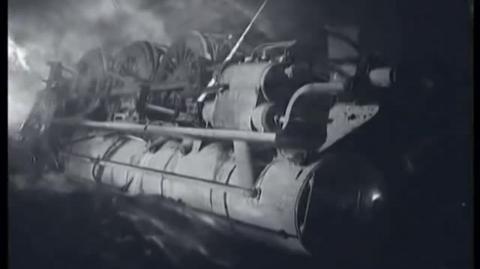Another Potential US Rail Disaster: 30 Tons of Ammonium Nitrate is Missing
The headline also has a hilarious typo: https://archive.ph/F4f6L
Support via donation:
Patreon: https://tinyurl.com/y2jothtp
Subscribestar: https://tinyurl.com/yyxov782
My books:
Blogger: https://tinyurl.com/y3tww3om
Wordpress: https://tinyurl.com/y54kofgl
Where to Find Me:
Substack: https://tarl.substack.com
Youtube: https://tinyurl.com/y6zc4quo
Bitchute: https://tinyurl.com/y55lzhlz
Rumble: https://tinyurl.com/y5692j87
Odysee: https://tinyurl.com/y4fsbqzz
Minds: https://tinyurl.com/y3ytf6ut
Twitter: https://tinyurl.com/yyle5u6s
Gab: https://tinyurl.com/y2rctakd
Gettr: https://www.gettr.com/user/styx666official
BTC: 17q1BfF2up8orEKN8DQgpEPX83RfbAZ5QL
ETH: 0x956e7aF6706C3b5E2cf7e15c16c7018c4f42aF79
LTC: LQNJed6vDhR4U4LB7g8jGep4UQ7yeqJdPw
Dogecoin: DNYSanJEY8fbxUzwjTJWA3d1Sna9hra4NJ
BCH: qz2wtp2w8grldn7gw5guqc42zxsgwuen8qxk49mhv9
SHIB: 0x956e7aF6706C3b5E2cf7e15c16c7018c4f42aF79
#Rail #California
0



 SoloMan Zone
SoloMan Zone
 AgentofSocialMediaChaos
AgentofSocialMediaChaos
 Redacted News
Redacted News
 Timcast IRL
Timcast IRL
 LiberumArbitrium
LiberumArbitrium


 mrghoster
mrghoster

 Raging Golden Eagle
Raging Golden Eagle
 Styxhexenhammer666
Styxhexenhammer666
 AwakenWithJP
AwakenWithJP
 TheQuartering
TheQuartering

 NPCinthecity
NPCinthecity



 RedKnight
RedKnight

Log in to comment
Mixing ammonium nitrate with the correct proportion of diesel makes Anfo.
Getting an appropriate length of a suitable fuse, a detonator, half a stick of gelignite - and you have a HUGE bomb.
30,000 Kilos makes (speculating from a distant memory) about a 31,000 kilo bomb....
The trouble is that it's not the best or most powerful powerful explosive ever - but the base ingredients are cheap, easy to get and simple to formulate... and up to a point - it's very very stable and safe - AND it's shit easy to set off....
This is why it's such a GOOD explosive....
So with legit uses - as fertiliser etc., it's really good, most farms have stockpiles of it and stealing enough for apparently illegitimate purposes, is not that hard - sympathisers or nay, compared to say a mining camps supply of explosive or a military base.
The question is what purposes is it being stolen for and how much has been stolen and what kind of target or targets is it intended for.?
Good Olde Timothy Mc Veigh had a bug up his arse about the FBI etc...
I think he had close to 3000Kg of ANFO - in assorted compositions.
https://en.wikipedia.org/wiki/....Oklahoma_City_bombin
https://upload.wikimedia.org/w....ikipedia/commons/thu
Wikipedia: ANFO
ANFO (/ˈænfoʊ/ AN-foh)[1] (or AN/FO, for ammonium nitrate/fuel oil) is a widely used bulk industrial explosive. It consists of 94% porous prilled ammonium nitrate (NH4NO3) (AN), which acts as the oxidizing agent and absorbent for the fuel, and 6% number 2 fuel oil (FO).[2] The use of ANFO originated in the 1950s.[3]
ANFO accounts for an estimated 90% of the 2.7 million tonnes (6 billion pounds) of explosives used annually in North America.[4][failed verification] It has found wide use in coal mining, quarrying, metal ore mining, and civil construction in applications where its low cost and ease of use may outweigh the benefits of other explosives, such as water resistance, oxygen balance, higher detonation velocity, or performance in small-diameter columns. ANFO is also widely used in avalanche hazard mitigation.[5]
Chemistry
The chemistry of ANFO detonation is the reaction of ammonium nitrate with a long-chain alkane (CnH2n+2) to form nitrogen, carbon dioxide, and water. In an ideal stoichiometrically balanced reaction, ANFO is composed of about 94.5% AN and 5.5% FO by weight. In practice, a slight excess of fuel oil is added, as underdosing results in reduced performance while overdosing merely results in more post-blast fumes.[6] When detonation conditions are optimal, the aforementioned gases are the only products. In practical use, such conditions are impossible to attain, and blasts produce moderate amounts of toxic gases such as carbon monoxide and nitrogen oxides (NOx).
The fuel component of ANFO is typically diesel, but kerosene, coal dust, racing fuel, or even molasses have been used instead. Finely powdered aluminium in the mixture will sensitise it to detonate more readily.[7]
Explosive properties
ANFO is highly insensitive, making it a tertiary explosive (or a "blasting agent"). Without a sensitizer, it cannot be detonated by a typical (such as No. 8) blasting cap with the small amount of primary explosives within. A larger quantity of secondary explosive, known as a primer or a booster, must be used.[8] One or two sticks of dynamite were historically used; current practice is to use Tovex or cast boosters of pentolite (TNT/PETN or similar compositions).[9]
ANFO is technically a high explosive in that it decomposes through detonation rather than deflagration at a velocity higher than the speed of sound in the material, but the low sensitivity means that it is not generally regulated as such. ANFO has a moderate velocity compared to other industrial explosives, measuring 3,200 m/s in 130 mm (5 in) diameter, unconfined, at ambient temperature.[8] It is described as a non-ideal high explosive, as its explosive velocity is far from the thermodynamic ideal due to its porosity and the phase separation of its two components.[10]
Industrial use
In the mining industry, the term ANFO specifically describes a mixture of solid ammonium nitrate prills and diesel fuel. Other explosives based on the ANFO chemistry exist; the most commonly used are emulsions. They differ from ANFO in the physical form the reactants take. The most notable properties of emulsions are water resistance and higher bulk density.
While the density of pure crystalline ammonium nitrate is 1700 kg/m3, individual prills of explosive-grade AN measure approximately 1300 kg/m3. Their lower density is due to the presence of a small spherical air pocket within each prill: this is the primary difference between AN sold for blasting and that sold for agricultural use. These voids are necessary to sensitize ANFO: they create so-called "hot spots".[a] Finely powdered aluminium can be added to ANFO to increase both sensitivity and energy;[10] in commercial usages however, this has fallen out of favor due to cost.
ANFO has a bulk density of about 840 kg/m3. In surface mining applications, it is typically loaded into boreholes by dedicated trucks that mix the AN and FO components immediately before the product is dispensed. In underground mining applications, ANFO is typically blow-loaded.
AN is highly hygroscopic, readily absorbing water from air. In humid environments, absorbed water interferes with its explosive function.[citation needed] AN is fully water-soluble; as such, it cannot be loaded into boreholes that contain standing water. When used in wet mining conditions, considerable effort must be taken to remove standing water and install a liner in the borehole; it is generally more productive to instead use a water-resistant explosive such as emulsion.
Regulation
In most jurisdictions, ammonium nitrate need not be classified as an explosive for transport purposes; it is merely an oxidizer. Mines typically prepare ANFO on-site using the same diesel fuel that powers their vehicles. While many fuels can theoretically be used, the low volatility and cost of diesel make it ideal.
ANFO under most conditions is detonator–insensitive, so it is legally classified as a blasting agent (tertiary explosive)[11] and not a high explosive.[12]
Ammonium nitrate is widely used as a fertilizer in the agricultural industry. It is also found in instant cold packs. In many countries, its purchase and use are restricted to buyers who have obtained the proper license.
Disasters
Main article: List of ammonium nitrate disasters
Unmixed ammonium nitrate can decompose explosively, and has been responsible for several industrial disasters, including the following:
1921 Oppau explosion in Germany
1947 Texas City disaster in Texas City, Texas
2004 Ryongchon disaster in North Korea
2011 Norway attacks in Oslo, Norway
2013 West Fertilizer Company explosion in West, Texas
2015 Tianjin explosions
2020 Beirut explosion
Environmental hazards include eutrophication in confined waters and nitrate/gas oil contamination of ground or surface water.[13]
Paramilitary use
ANFO was used in 1970 when protests by students became violent at the University of Wisconsin–Madison, who learned how to make and use ANFO from a Wisconsin Conservation Department booklet entitled Pothole Blasting for Wildlife,[6][14] resulting in the Sterling Hall bombing.
ANFO used to be widely used by the FLNC (National Liberation Front of Corsica), along with f15 explosive. Five containers of 500 kilograms (1,100 pounds) each were used to blow up the Tax Office building in Bastia on 28 February 1987.[citation needed]
The ANFO car bomb was adopted by the Provisional IRA in 1972 and, by 1973, the Troubles were consuming 21,000 kilograms (47,000 pounds) of ammonium nitrate for the majority of bombs.[15] The Ulster Volunteer Force (UVF) also made use of ANFO bombs, often mixing in gelignite as a booster, in the Dublin and Monaghan bombings of May 1974 which killed 34 people & injured almost 300, ANFO car bombs were used in Dublin.[16] The IRA detonated an ANFO truck bomb on Bishopsgate in London in 1993, killing one and causing £350 million in damage. It has also seen use by groups such as the Revolutionary Armed Forces of Colombia and ETA. In 1992, Shining Path perpetrated the Tarata bombing in Lima, Peru, using two ANFO truck bombs.
A more sophisticated variant of ANFO (ammonium nitrate with nitromethane as the fuel, called ANNM) was used in the 1995 Oklahoma City bombing.[citation needed]
The Shijiazhuang bombings (Chinese: 靳如超爆炸案 or 石家庄"3·16"特大爆炸案) rocked the city of Shijiazhuang, China, on 16 March 2001. A total of 108 people were killed, and 38 others injured when, within a short time, several ANFO bombs exploded near four apartment buildings.[17]
In November 2009, the government of the North West Frontier Province (NWFP) of Pakistan imposed a ban on ammonium sulfate, ammonium nitrate, and calcium ammonium nitrate fertilizers in the Upper Dir, Lower Dir, Swat, Chitral and Malakand districts (the former Malakand Division) following reports that those chemicals were used by militants to make explosives.[citation needed]
In April 2010, police in Greece confiscated 180 kg of ANFO and other related material stashed in a hideaway in the Athens suburb of Kareas. The material was believed to be linked to attacks previously carried out by the "Revolutionary Struggle" terrorist group.[citation needed]
In January 2010, President Hamid Karzai of Afghanistan also issued a decree banning the use, production, storage, purchase, or sale of ammonium nitrate, after an investigation showed militants in the Taliban insurgency had used the substance in bomb attacks.[18][19][20]
On 22 July 2011, an aluminium powder-enriched ANNM explosive, with total size of 950 kg (150 kg of aluminium powder), increasing demolition power by 10–30% over plain ANFO, was used in the Oslo bombing.[21][22]
On 13 April 2016, two suspected IRA members were stopped in Dublin with 67 kg of ANFO.[23]
On 6 March 2018, 8 members of the extreme right neo-Nazi group Combat 18 were arrested in Athens, Greece, accused of multiple attacks on immigrants and activists. They had 50 kg of ANFO in their possession.[24]
References
It was found by the IRA, in response to using low-brisance AN fertilizers, that "hot spots" can be created by blending powdered sugar into the ANFO mixture, effectively sensitizing the mixture to mining-standard prilled ammonium nitrate effectiveness in which the interaction of the detonation front with a spherical void concentrates energy. Blasting-grade AN prills are typically between 0.9 and 3.0 mm in diameter.
"ANFO | explosive". Encyclopedia Britannica. Retrieved 4 May 2019.
Cook, Melvin A. (1974). The Science of Industrial Explosives. IRECO Chemicals. p. 1. ASIN B0000EGDJT.
Encyclopædia Britannica
Edward M. Green (June 2006). "Explosives regulation in the USA" (PDF). Industrial Materials (465): 78. Retrieved 3 March 2013.
Cook, Melvin A. (1974). The Science of Industrial Explosives. IRECO Chemicals. p. 2. ASIN B0000EGDJT.
Mathiak, Harold A. (1965). Pothole Blasting for Wildlife. Wisconsin Conservation Department, Madison, Wisconsin 53701. p. 11.
Singh, R. D. (2005). Principles and Practices of Modern Coal Mining. New Age International. p. 532. ISBN 9788122409741.
Blasters' Handbook (15th ed.). E. I. du Pont de Nemours & Company. 1969. pp. 64–68. ASIN B000JM3SD0.
"Explosives – ANFO (Ammonium Nitrate – Fuel Oil)". GlobalSecurity.org. Retrieved 3 March 2013.
Fabin, M; Jarosz, T (1 October 2021). "Improving ANFO: Effect of Additives and Ammonium Nitrate Morphology on Detonation Parameters". Materials. 14 (19). doi:10.3390/ma14195745. PMID 34640139.
Cook, Melvin A. (1974). The Science of Industrial Explosives. IRECO Chemicals. p. 16. ASIN B0000EGDJT.
"Explosives and blasting agents". Occupation Safety & Health Administration. Retrieved 3 March 2013.
P. Cosgrove. Ammogex Material Safety Data Sheet, Document No: HS-MSDS-03, Irish Industrial Explosives Ltd
Mike Davis (2007). Buda's Wagon: A Brief History of the Car Bomb. New York: Verso. p. 53. ISBN 978-1844671328. LCCN 2007274127..
Henry Stanhope (8 November 1974). "The will to blow the lid off Ulster still remains strong". The Times. London.
"Bombs".
"石家庄九名制贩爆炸物的嫌犯被刑事拘留" [Shijiazhuang nine suspects of the sale of explosives were detained in criminal detention] (in Chinese). Beijing. 3 April 2001. Retrieved 12 August 2017.[permanent dead link]
"Afghanistan bans chemical used to make bombs; protesters denounce killings". Times Union. Albany, N.Y. Archived from the original on 7 June 2010.
"Afghanistan bans chemical used to make bombs". The Guardian. AP Foreign. 22 January 2010. Retrieved 3 March 2013.
Dexter Filkins (11 November 2009). "Bomb Material Cache Uncovered in Afghanistan". The New York Times. Retrieved 3 March 2013.
Stina Åshildsdatter Grolid; Unni Eikeseth (25 July 2011). "Slik virket trykkbølgen etter bomben" [Such seemed the shock wave after the bomb] (in Norwegian). NRK. Retrieved 28 July 2011.
Stigset, Marianne; Kremer, Josiane; Treloar, Stephen (27 July 2011). "Police in Norway Extend Terror Probe Across Europe After Breivik Attacks". Bloomberg.
Daniel Hickey (13 April 2016). "Two men appear in court charged with possession of 150 kg of homemade explosives". Irish Independent. Dublin. Retrieved 16 April 2016.
"Ο 'Τσαμπ' της 'Combat 18' και ο 'Λύκος' της Χρυσής Αυγής επιβεβαιώνουν τη λογική των 'συγκοινωνούντων δοχείων'".
External links
Wikimedia Commons has media related to ANFO.
Securing Ammonium Nitrate: Using Lessons Learned in Afghanistan to Protect the Homeland from IEDs: Hearing before the Subcommittee on Cybersecurity, Infrastructure Protection, and Security Technologies of the Committee on Homeland Security, House of Representatives, One Hundred Twelfth Congress, Second Session, 12 July 2012
Authority control: National Edit this at Wikidata
Israel United States
Category:
Binary explosives
~~~~~~~~~~~~~~~~~~~~~~~~~~~~~~~~~~~~~
As a side note - I would like a few hundred Kilos of it - for High Rate High Energy Forming (making steel domes etc), Explosive welding of dissimilar metals and alloys - like copper cladding onto stainless steel sheets, and removing stumps and some mining operations...
Other than that - I don't give much of a fuck for it really.
I would like to level off the top of a few mountains - so you have a big flat stable area to build upon and to set up research stations, well away from the unstable sides of the mountains etc....
But other than that, it's just like any other tool, if you have a legitimate reason for it, you get it, if not - it's just more shit taking up space and wasting resources....